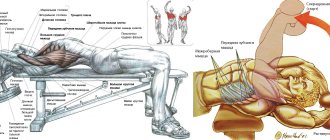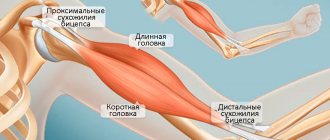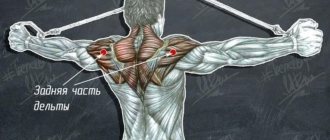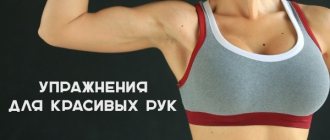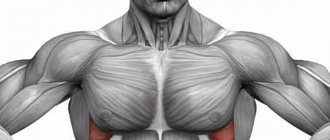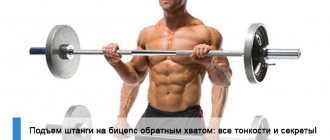Concentrated biceps curls can be seen quite often in the gym. There is an opinion that it is he who helps pump the biceps muscle to its peaks. But the scientific possibility of “appearance” of peaks on the hand of a person who is not genetically predisposed to this has not yet been proven. However, the exercise is popular. It allows you to use light to medium weights and work both biceps symmetrically.
Execution technique
Initial position
- The movement is performed from a sitting position;
- The athlete spreads his legs wide, bends forward, rests the elbow of his working hand on his thigh so as to fix its position;
- The back remains straight, the shoulders are away from the ears;
- The free hand can rest on the knee or thigh of the leg
Movement
- Due to the contraction of the biceps, the arm bends at the elbow joint;
- At the top point, at the peak of the contraction, you can linger, tensing your biceps;
- The arm extends slowly and under control;
- Inhale - while lowering, exhale - while contracting;
- There is no pause at the bottom, you need to immediately move in the opposite direction and contract the muscles again;
- The movement is performed in the same number of repetitions
Attention
- It is better not to bend your wrist in the exercise, so as not to use “extra” muscles and not take the load off the biceps;
- The movement is not “tailored” to be performed with significant weights. It will be better if it is performed with such a weight that the lift remains concentrated and the elbow does not move relative to the hip;
- You should not move your elbow away from your hip, otherwise the whole point of the exercise will be lost;
- Throwing the dumbbell down and performing extensions aggressively, until a “click” in the joint is also not recommended;
- The body should not perform “swings” or movements that help push the weight upward;
- You should not take the entire weight of the projectile “into the joint”, actively resting your elbow on your thigh.
It's a CONCENTRATED BICEPS LIFT, baby!
Recommendations
- This is a concentrated exercise, you need to strain your hand at the top as much as possible, your attention is focused on this;
- You should not select such a weight that it is impossible to independently lift the dumbbell from the lower position;
- It is better to place your legs so that there is a stable position; this is usually achieved by placing your feet wider than your shoulders;
- Hinging your wrist upward is a bad strategy and will overload your forearm;
- The amplitude should be large, this is not a reduced amplitude in exercises involving the brachialis and brachyradialis;
- The back should be kept neutral, the spine should be kept as straight and elongated as possible, without bending.
What muscles do the work?
As we already understood, the main load goes to the biceps; during execution, both heads receive tension. Their maximum stretching and contraction occurs, naturally with the full range of motion. The brachialis takes on a very small share of the work; this brachialis muscle is located under the biceps; if it is well developed, the biceps is pulled upward.
The brachialis muscle located on the forearm also comes into play, but the work is not significant, so this exercise primarily trains the biceps.
Execution technique
Concentrated lifts are not difficult to perform, but they have a couple of features, which will be discussed further. Step-by-step execution of the exercise.
- Sit on a bench and spread your legs in different directions; you don’t want to spread them too wide.
- Take a dumbbell in your hand (let’s say your right hand), and rest your left hand on your thigh.
- Lower your hand with the dumbbell down, you don’t need to straighten it as much as possible, we recommend slight tension and bending, this will be the starting position.
- Inhale and lift the dumbbell with a smooth movement without lifting your elbow from your hip.
- At the top point of the lift, the dumbbell should be at the same level as your shoulder; we recommend pausing for a second there.
- Then we slowly begin to lower the dumbbell to its original position.
- We recommend doing 3 sets of 12 repetitions on one arm.
Some tips on technique
- Take a comfortable position, your legs should be close to the floor and your hand to your knee.
- Try not to swing your body while performing; only the elbow joint should be involved in the work.
- The triceps should be close to your thigh and your elbow should be slightly below your hip.
- For a good and productive workout of the biceps, during execution, practice supination, raising your elbow and slightly wrapping your forearm.
- The weight must be selected carefully; you must perform at least 8 repetitions per approach, and the number of approaches is from 3 to 5.
- To get a good peak, pause in the middle of the amplitude.
Video:
Execution options
- Standing concentrated biceps curl . In fact, this exercise comes in two forms. The athlete can either use a support or bench to stabilize the forearm, or rest the elbow on the body so as to prevent movement in the forearm. Both options are recommended only for a healthy back, and are not used if there are problems;
- Lifting with supination . This is the name for the classic dumbbell curl for biceps in a concentrated sitting style, but when the athlete turns his arm palm up;
- Concentration style sit-up on a Larry Scott bench . Yes, this popular single dumbbell variation will duplicate the simple lift exactly;
- Exercise on the lower block . Using the handle of the lower block allows you to make the bending even more targeted and concentrated. This way the athlete will be able to ensure constant tension and muscle work.
How to do it?
The concentrated biceps curl is a simple exercise in which it is almost impossible to make a mistake. But a certain algorithm of actions must be followed:
- Take a comfortable position on a horizontal bench, then spread your legs to the sides (they should be slightly wider than your shoulders).
- Then pick up a dumbbell and place your elbow on the inside of your thigh. Lower the hand with the load almost to the end, but without completely straightening.
- Inhale and, keeping your elbow in the same place, contract your biceps and lift the dumbbell. The lift should be somewhere up to the shoulder position. At the moment of maximum effort, exhale. When the projectile reaches the top point, fix the position for 2-3 seconds.
- Begin to straighten your arm, gradually returning it to its previous position. The lowering should be slightly slower than the ascent. Do the required number of repetitions.
As for variations, there is little choice here - you can use dumbbells or work on a crossover.
Analysis of the exercise
Working muscles
- The main mover is the biceps of the arm; Assistant muscles – brachialis, muscles of the forearm.
pros
- This is the highest amplitude movement, it helps to stretch the biceps to the maximum;
- Simple equipment allows you to train at home, or in the most basic gym; Many exercise options help you perform the movement in any conditions;
- It has been empirically proven that this exercise can make the arms more voluminous and help build the “peak” of the biceps, although electromyograph studies do not prove this;
- Assistance due to swinging is completely eliminated, the elbows are fixed;
- There is variability - if you lift a dumbbell with a supinated grip rather than a pronated one, you can use the brachioradialis muscle;
- The exercise is technically simple, does not require significant skills, and can be performed by both beginners and professionals.
Flaws
- This exercise eliminates the use of significant weights. It is designed to sharpen your form, not to build large amounts of arm muscle. By training only with this movement it is unlikely that you will be able to “swing” your arms
Preparation
In order to pump up your biceps in a concentrated style, you must first warm up well. Despite its apparent simplicity, the exercise may not be safe if you perform it while actively adding weight without warming up. It’s rare that anyone starts with a concentrated biceps curl; usually, back exercises or other biceps movements are done first in the workout, and this exercise comes somewhere closer to the end of the workout.
Concentration style lifts are often used in a variety of ways to increase training volume and intensity. Some athletes like to do this exercise with drop sets, others - exclusively in 3-4 sets of 12-15 repetitions, but carefully monitoring each movement.
Proper execution
- The feet should be spread as wide as possible. Setting your legs too narrow in a sitting position can lead to the body tilting in one direction or another. You should also actively spread your knees so that the position is stable. The optimal load will help you choose not only the correct separation of the feet, but also the active involvement of the thigh muscles. You need to push off the floor with your feet. In this case, the bench should not be too high so that the knee joints are not bent at an obtuse angle;
- The movement is performed only by the forearm. The elbow rests on the thigh throughout the exercise, which ensures a stable position of the shoulder and disables it from work;
- This curl should be performed with maximum concentration on the biceps, the athlete fixes himself at the highest point and contracts the muscles as much as possible;
- There is no need to throw your hand with the dumbbell down; it is recommended to lower it quite slowly and under control;
- Exhale when lifting the weight, inhale when lowering it
Curling an arm with a dumbbell to the opposite shoulder
Errors
- Cheating with the body;
- Lifting the hand from the hip;
- “Standing up” on the elbow joint
Efficiency Tips
- This is a “finishing” exercise. All movements are performed with relatively light weight. You can try to work “after refusal”, helping yourself with your free hand;
- In this exercise, 2-3 drop sets with lighter weight work effectively;
- Some athletes like to use rubber shock absorbers for the biceps, putting them on the working arm and, as it were, “locking” the blood in the biceps to increase the load
Initial position
Take a dumbbell of the desired weight with your right hand and sit on a bench. Spread your legs, press your feet firmly to the floor, lean forward slightly. Place your left hand on your left thigh. And press the elbow of your right hand to the inner part of your right thigh. Your right shoulder should be vertical. The arm with the dumbbell is completely straightened, and the dumbbell does not touch the floor.
Concentrated curls. Exercise technique.
Gently bend your right arm, squeezing your biceps. The elbow and shoulder of the right hand should be motionless. The arm should bend completely. Stay in this position for a second, feel how your biceps contract as much as possible.
Then smoothly straighten your arm with the dumbbell and immediately begin to bend it again. Complete the required number of repetitions. It is recommended to count the repetitions so that you can do the same with the other hand.
After completing the required number of repetitions with your right hand, transfer the dumbbell to your left hand. Place your right palm on your right thigh, and press your left elbow to the inside of your left thigh. Do the required number of repetitions for your left hand. This was one approach.
Concentrated dumbbell curls while seated
Then rest and move on to the next set. If you get it, you can perform all sets of concentrated curls continuously, changing hands.
Inclusion in the program
This movement can hardly be put first on the plan. Few people start with it, except perhaps those who work their arms 3 times a week, and have one easy workout among all this abundance of biceps exercises. Some athletes strive to perform concentrated flexion with 2-3 movements, but this is not entirely true. Due to its nature, it can only be final.
Usually 2-3 sets of 10-12 repetitions are performed per set. It is possible to increase to 12-15, this is an individual indicator.
Work of muscles and joints
The exercise is isolating, so the biceps receives the main load; the forearm is also slightly loaded, however, the latter is loaded in absolutely any exercise. The shoulder joint is fixed, so the deltoid muscles should not steal the load, moreover, if you violate the technique and they still participate in the range of motion, then ask yourself the question why you do concentrated bending at all, because then it is more effective to do some others biceps exercises. No, you must clearly understand that the progression of loads should be carried out through the development of the target muscle group, and not through the addition of additional ones.
The joints in this exercise are not in a worse position, however, the elbow joint takes all the load, since, as already written above, the shoulder joint is fixed. However, the weight of the dumbbell is relatively light and the speed of the exercise is slow, making it very difficult to damage your elbow. The only possibility of damaging the elbow joint exists only if the athlete tries to throw back the dumbbell by turning the body. We also do not recommend raising your arm too high, as this will take the load off the biceps and transfer it to the elbow.
Concentrated biceps curl
The exercise selectively affects the biceps, pumping the middle and lower parts of the muscle. The biceps takes shape.
Execution technique
- Sit on the edge of a bench with your feet much wider than shoulder-width apart and pressed firmly into the floor. Grasp the dumbbell with one hand, clasping it from below (palm up). Let's say you start with your right hand.
- Take your starting position. With the palm of your left hand, you rest your choice on your left side, thigh or knee. The right arm with dumbbells is slightly bent at the elbow joint. You lean forward and rest the back of your right arm (the bottom of your triceps) on the inside of your right thigh.
- Inhale and hold your breath. The dumbbell goes up using the biceps of the right arm. After going through a difficult section of the climb, you can exhale a little. Raise the dumbbell to your chest.
- Almost touching the dumbbell to your chest, stop motionless and tighten your biceps. As you lower the dumbbell, exhale completely.
- Do not use your torso to lift the dumbbell. This is a biceps only job!
- You can move on to the exercise for the left hand after a full set of the right one.
Recommendations for implementation
- Throughout the set, ensure that the lower part of the triceps is firmly fixed on the inside of the thigh.
- The correct position of the back, which will not cause compression of the intervertebral discs, is when the lower back bends slightly, and the shoulders and chest are straightened.
- Hold your breath at the indicated moments so that you can keep your back correct and allow you to perform the exercise with a heavier dumbbell.
- Elbow flexion is produced by the biceps, brachialis and brachioradialis muscles of the body. If desired, you can load all three muscles. To do this, grab the dumbbell with a so-called neutral grip. With a neutral grip, the palm faces the body.
- The biceps will work harder when a neutral grip is combined with an upward palm turn. When moving the dumbbell upward, the palm first stands with its edge relative to the plane of the floor, at the point of maximum amplitude the palm is facing upward.
Secrets and nuances
To get maximum results and squeeze all the juice out of your biceps, you should consider the following points:
- Watch your hand move. During the entire period of lifting and lowering the load, it should be in a stationary position, and only the forearm should move.
- In the top position, rotate the hand so that the little finger is slightly higher than the thumb.
- Try not to fully extend your arm as this may cause injury.
- Concentrated biceps curls should be the last one in training this muscle group. In this case, it is necessary to start with the weaker hand (most often the left).
- To increase the amplitude, you can place a small step platform under the supporting leg.
- The rise should be 2-3 times faster than the descent.
- To improve results, you should gradually increase the weight and, if necessary, help yourself with the other hand (or ask a partner).
- The number of sets should be 3-5, and the number of repetitions should be 10-12.
- During the exercise, watch your muscles - they should be as tense as possible throughout the entire approach.
Recommendations
Maximum effectiveness of the exercise can be achieved if, at the point of maximum contraction of the biceps, you pause for 3-4 seconds, tensing your biceps.
When bending your arm, try not to use your core. In this case, you will reduce the load on the biceps, which will make the exercise less useful.
The shoulder of the working hand must be located below the shoulder of the non-working hand.
Make sure that during the exercise your elbow does not “walk” and remains pressed to the inside of your thigh.
To reduce the load on the elbow joint and reduce the likelihood of injury, the tempo of the exercise can be slowed down, but its effectiveness will hardly be affected.
